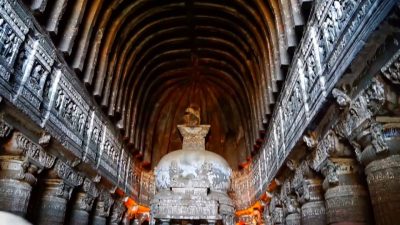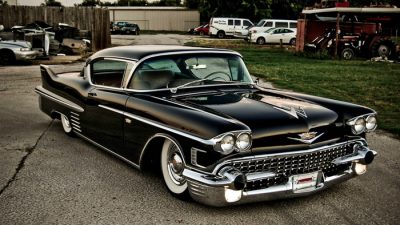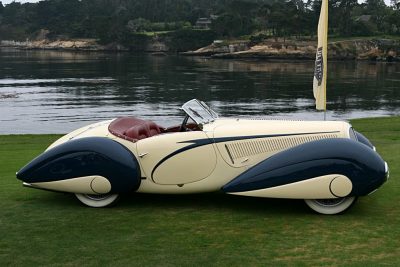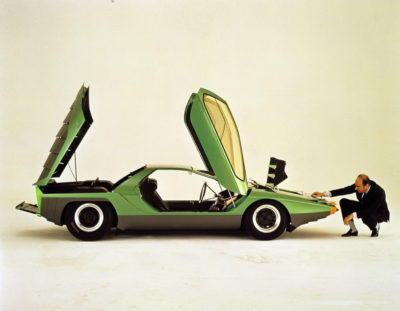
When erhu artist WeiWei Wuu took to the stage at Shanghai Concert Hall on April 30, she delivered a show that could be described as out of the ordinary.
The Chinese audience likely expected to see a woman playing the traditional instrument while seated, wearing a cheongsam (the body-hugging dress native to Shanghai) and playing ballads that evoke a sentimental nostalgia. Wuu, however, was resplendent in fuchsia, mint and gold, and began her performance by walking through the crowd playing a piece that had the jaunty rhythm of a Celtic jig. And the musical experimentation didn’t stop there: She also touched on rock, jazz and balladry during the concert, capping it off with accompaniment from a backing orchestra comprising 70 of her Japanese students.
“I really wanted to show people in my hometown just how much my Japanese students love playing niko,” Wuu says, using the Japanese word for the two-stringed Chinese fiddle.
The show was broadcast live over the radio and streamed online. Wuu mentions that she was pleased with local coverage of the bicultural event.
“Chinese listeners seemed to be impressed by the fact that the Japanese performers, my students, had devoted so much extracurricular time in pursuit of their passion for the erhu,” she says.
Wuu’s own musical pursuits began with passion for another instrument, the violin. Born in Shanghai in 1968, during the upheaval of China’s Cultural Revolution, she started learning it at the age of 5.
“We had to draw the curtains to attract as little attention as possible because I was studying Western music,” Wuu recalls. “That kind of thing was prohibited by the government in those days.”
In 1978, after revolution-era prohibitions were relaxed, a 10-year-old Wuu passed an audition to enter an elementary school connected to the Shanghai Conservatory of Music. She majored in the violin but also found herself intrigued by the erhu.
“It’s old and Oriental, like the sound of home for me,” she says.
After graduating from the prestigious Shanghai College of Theatre Arts in both violin and erhu, Wuu came to Japan in 1991 to continue studying the violin. “And for my love for Japanese TV dramas, which were so popular in Shanghai,” she adds with a grin.
Despite her original focus on Western classical music, Wuu’s time in Japan saw her gradually shift more toward the erhu. One of her initial influences was the music of French jazz violinist Stephane Grappelli (1908-97), who had a lyrical style of playing that was different from classical violin.
“I wanted to play the violin like him and tried it myself, but I just couldn’t do it,” Wuu says, adding that she believes this was because she couldn’t break free from conventions she learned as a child. In contrast, the erhu provided a sense of artistic freedom.
“For me, the erhu became the instrument with which I could try new things,” she says.
This open-minded approach led to further experimentation across genres in her professional career, including collaborations with musicians such as composer Ryuichi Sakamoto, violinist Taro Hakase and American saxophonist Kenny G. She also joined Goseiki, a band led by Bakufu Slump drummer Funky Sueyoshi that merged rock and jazz elements with traditional Chinese sounds. Her encounters with rock prompted Wuu to try performing the erhu while standing, rather than in the customary seated position.
“You stand when you play rock music, don’t you? However, there was no such precedent in performing erhu,” she says.
Some members of the erhu community objected to Wuu’s standing style, but she persisted, inventing a special belt with a small stand so she could remain on her feet while playing. This also meant that she could walk, and even dance, around the stage during her concerts.
The musician’s shows are often described as “vigorous,” and her tendency to flit between different genres of music is reflected on her albums. Her major-label debut came in 2002 with “Memories of the Future,” and her most recent, “Legacy,” coincides with the 15th anniversary of her debut.
The new full-length includes covers of Nikolai Rimsky-Korsakov’s “Flight of the Bumblebee,” Badfinger’s “Without You” and the song “He’s a Pirate” from the film “Pirates of the Caribbean: The Curse of the Black Pearl.” “Legacy” also features five original pieces with the highlight being “20th,” which was recorded with her 250 pupils.
“We weren’t able to get such a large venue (to record ’20th’), so we did it in parts and recorded more than 20 times to include each of the members. We mixed them together afterward,” Wuu says while pointing out the list of performers’ names written in the album’s liner notes.
The erhu was often used by nomadic people in funeral rites because of its soft wailing sound, which some describe as being similar in tone to a woman’s voice.
“The erhu has a motherly sound,” she points out. “I’m moved by it from deep inside my belly, while the sound of the violin comes more from my mind.”
It’s interesting that Wuu chooses “motherly” to describe the instrument’s sound. She speaks adoringly of her students, recalling that her life as a teacher began in 1993 after she received several requests from Japanese people to teach them the erhu. Her group of students, including the 70 that performed with her in Shanghai, is called the Shingen Niko Gakudan, which translates as the “Heartstrings Erhu Orchestra.”
“I was a bit of an introvert when I was young, a child of few words. My ideas were different from those of the other kids, and I found it hard to make myself understood,” Wuu says. “It was only after I came to Japan that I realized I could actually be a pioneer, because what I wanted to do was something that didn’t already exist.”
You can visit WeiWei Wuu at WeiWei’s Cafe, a spot to enjoy snacks and music, located at 3-7-13 Koyama, Shinagawa-ku, Tokyo (03-6426-9628). The WeiWei Wuu 15th Anniversary Concert “Legacy” tour heads to Curian Concert Hall in Shinagawa Ward, Tokyo, on June 17 (?3,000; 3 p.m. doors open); Hotel Mikino in Gero, Gifu Prefecture, on July 23 (?3,000; 3 p.m. doors open); Kokoan Cottage in Shirakawago, Gifu Prefecture on July 10 (?2,000; 7 p.m. start); Studio Wuu in Kashiwa, Chiba Prefecture, on July 23 (?4,000; 4 p.m. start); the Former Hong Kong and Shanghai Bank Nagasaki Branch Museum in Nagasaki on July 26 (?4,000; 6:30 p.m. start); Hotel Shiroyama in Kagoshima (?20,000 including dinner; 7:30 p.m. start); Salle Mandjar in Miyazaki (?4,000; 3 p.m. start); C.I.B. in Kumamoto (?4,000; 3 p.m. start); and Gate’s 7 in Fukuoka (?4,000; 7 p.m. start). For more information, visit www.weiwei-wuu.com.
 When erhu artist WeiWei Wuu took to the stage at Shanghai Concert Hall on April 30, she delivered a show that could be described as out of the ordinary.
The Chinese audience likely expected to see a woman playing the traditional instrument while seated, wearing a cheongsam (the body-hugging dress native to Shanghai) and playing ballads that evoke a sentimental nostalgia. Wuu, however, was resplendent in fuchsia, mint and gold, and began her performance by walking through the crowd playing a piece that had the jaunty rhythm of a Celtic jig. And the musical experimentation didn’t stop there: She also touched on rock, jazz and balladry during the concert, capping it off with accompaniment from a backing orchestra comprising 70 of her Japanese students.
“I really wanted to show people in my hometown just how much my Japanese students love playing niko,” Wuu says, using the Japanese word for the two-stringed Chinese fiddle.
The show was broadcast live over the radio and streamed online. Wuu mentions that she was pleased with local coverage of the bicultural event.
“Chinese listeners seemed to be impressed by the fact that the Japanese performers, my students, had devoted so much extracurricular time in pursuit of their passion for the erhu,” she says.
Wuu’s own musical pursuits began with passion for another instrument, the violin. Born in Shanghai in 1968, during the upheaval of China’s Cultural Revolution, she started learning it at the age of 5.
“We had to draw the curtains to attract as little attention as possible because I was studying Western music,” Wuu recalls. “That kind of thing was prohibited by the government in those days.”
In 1978, after revolution-era prohibitions were relaxed, a 10-year-old Wuu passed an audition to enter an elementary school connected to the Shanghai Conservatory of Music. She majored in the violin but also found herself intrigued by the erhu.
“It’s old and Oriental, like the sound of home for me,” she says.
After graduating from the prestigious Shanghai College of Theatre Arts in both violin and erhu, Wuu came to Japan in 1991 to continue studying the violin. “And for my love for Japanese TV dramas, which were so popular in Shanghai,” she adds with a grin.
Despite her original focus on Western classical music, Wuu’s time in Japan saw her gradually shift more toward the erhu. One of her initial influences was the music of French jazz violinist Stephane Grappelli (1908-97), who had a lyrical style of playing that was different from classical violin.
“I wanted to play the violin like him and tried it myself, but I just couldn’t do it,” Wuu says, adding that she believes this was because she couldn’t break free from conventions she learned as a child. In contrast, the erhu provided a sense of artistic freedom.
“For me, the erhu became the instrument with which I could try new things,” she says.
This open-minded approach led to further experimentation across genres in her professional career, including collaborations with musicians such as composer Ryuichi Sakamoto, violinist Taro Hakase and American saxophonist Kenny G. She also joined Goseiki, a band led by Bakufu Slump drummer Funky Sueyoshi that merged rock and jazz elements with traditional Chinese sounds. Her encounters with rock prompted Wuu to try performing the erhu while standing, rather than in the customary seated position.
“You stand when you play rock music, don’t you? However, there was no such precedent in performing erhu,” she says.
Some members of the erhu community objected to Wuu’s standing style, but she persisted, inventing a special belt with a small stand so she could remain on her feet while playing. This also meant that she could walk, and even dance, around the stage during her concerts.
The musician’s shows are often described as “vigorous,” and her tendency to flit between different genres of music is reflected on her albums. Her major-label debut came in 2002 with “Memories of the Future,” and her most recent, “Legacy,” coincides with the 15th anniversary of her debut.
The new full-length includes covers of Nikolai Rimsky-Korsakov’s “Flight of the Bumblebee,” Badfinger’s “Without You” and the song “He’s a Pirate” from the film “Pirates of the Caribbean: The Curse of the Black Pearl.” “Legacy” also features five original pieces with the highlight being “20th,” which was recorded with her 250 pupils.
“We weren’t able to get such a large venue (to record ’20th’), so we did it in parts and recorded more than 20 times to include each of the members. We mixed them together afterward,” Wuu says while pointing out the list of performers’ names written in the album’s liner notes.
The erhu was often used by nomadic people in funeral rites because of its soft wailing sound, which some describe as being similar in tone to a woman’s voice.
“The erhu has a motherly sound,” she points out. “I’m moved by it from deep inside my belly, while the sound of the violin comes more from my mind.”
It’s interesting that Wuu chooses “motherly” to describe the instrument’s sound. She speaks adoringly of her students, recalling that her life as a teacher began in 1993 after she received several requests from Japanese people to teach them the erhu. Her group of students, including the 70 that performed with her in Shanghai, is called the Shingen Niko Gakudan, which translates as the “Heartstrings Erhu Orchestra.”
“I was a bit of an introvert when I was young, a child of few words. My ideas were different from those of the other kids, and I found it hard to make myself understood,” Wuu says. “It was only after I came to Japan that I realized I could actually be a pioneer, because what I wanted to do was something that didn’t already exist.”
You can visit WeiWei Wuu at WeiWei’s Cafe, a spot to enjoy snacks and music, located at 3-7-13 Koyama, Shinagawa-ku, Tokyo (03-6426-9628). The WeiWei Wuu 15th Anniversary Concert “Legacy” tour heads to Curian Concert Hall in Shinagawa Ward, Tokyo, on June 17 (?3,000; 3 p.m. doors open); Hotel Mikino in Gero, Gifu Prefecture, on July 23 (?3,000; 3 p.m. doors open); Kokoan Cottage in Shirakawago, Gifu Prefecture on July 10 (?2,000; 7 p.m. start); Studio Wuu in Kashiwa, Chiba Prefecture, on July 23 (?4,000; 4 p.m. start); the Former Hong Kong and Shanghai Bank Nagasaki Branch Museum in Nagasaki on July 26 (?4,000; 6:30 p.m. start); Hotel Shiroyama in Kagoshima (?20,000 including dinner; 7:30 p.m. start); Salle Mandjar in Miyazaki (?4,000; 3 p.m. start); C.I.B. in Kumamoto (?4,000; 3 p.m. start); and Gate’s 7 in Fukuoka (?4,000; 7 p.m. start). For more information, visit www.weiwei-wuu.com.
When erhu artist WeiWei Wuu took to the stage at Shanghai Concert Hall on April 30, she delivered a show that could be described as out of the ordinary.
The Chinese audience likely expected to see a woman playing the traditional instrument while seated, wearing a cheongsam (the body-hugging dress native to Shanghai) and playing ballads that evoke a sentimental nostalgia. Wuu, however, was resplendent in fuchsia, mint and gold, and began her performance by walking through the crowd playing a piece that had the jaunty rhythm of a Celtic jig. And the musical experimentation didn’t stop there: She also touched on rock, jazz and balladry during the concert, capping it off with accompaniment from a backing orchestra comprising 70 of her Japanese students.
“I really wanted to show people in my hometown just how much my Japanese students love playing niko,” Wuu says, using the Japanese word for the two-stringed Chinese fiddle.
The show was broadcast live over the radio and streamed online. Wuu mentions that she was pleased with local coverage of the bicultural event.
“Chinese listeners seemed to be impressed by the fact that the Japanese performers, my students, had devoted so much extracurricular time in pursuit of their passion for the erhu,” she says.
Wuu’s own musical pursuits began with passion for another instrument, the violin. Born in Shanghai in 1968, during the upheaval of China’s Cultural Revolution, she started learning it at the age of 5.
“We had to draw the curtains to attract as little attention as possible because I was studying Western music,” Wuu recalls. “That kind of thing was prohibited by the government in those days.”
In 1978, after revolution-era prohibitions were relaxed, a 10-year-old Wuu passed an audition to enter an elementary school connected to the Shanghai Conservatory of Music. She majored in the violin but also found herself intrigued by the erhu.
“It’s old and Oriental, like the sound of home for me,” she says.
After graduating from the prestigious Shanghai College of Theatre Arts in both violin and erhu, Wuu came to Japan in 1991 to continue studying the violin. “And for my love for Japanese TV dramas, which were so popular in Shanghai,” she adds with a grin.
Despite her original focus on Western classical music, Wuu’s time in Japan saw her gradually shift more toward the erhu. One of her initial influences was the music of French jazz violinist Stephane Grappelli (1908-97), who had a lyrical style of playing that was different from classical violin.
“I wanted to play the violin like him and tried it myself, but I just couldn’t do it,” Wuu says, adding that she believes this was because she couldn’t break free from conventions she learned as a child. In contrast, the erhu provided a sense of artistic freedom.
“For me, the erhu became the instrument with which I could try new things,” she says.
This open-minded approach led to further experimentation across genres in her professional career, including collaborations with musicians such as composer Ryuichi Sakamoto, violinist Taro Hakase and American saxophonist Kenny G. She also joined Goseiki, a band led by Bakufu Slump drummer Funky Sueyoshi that merged rock and jazz elements with traditional Chinese sounds. Her encounters with rock prompted Wuu to try performing the erhu while standing, rather than in the customary seated position.
“You stand when you play rock music, don’t you? However, there was no such precedent in performing erhu,” she says.
Some members of the erhu community objected to Wuu’s standing style, but she persisted, inventing a special belt with a small stand so she could remain on her feet while playing. This also meant that she could walk, and even dance, around the stage during her concerts.
The musician’s shows are often described as “vigorous,” and her tendency to flit between different genres of music is reflected on her albums. Her major-label debut came in 2002 with “Memories of the Future,” and her most recent, “Legacy,” coincides with the 15th anniversary of her debut.
The new full-length includes covers of Nikolai Rimsky-Korsakov’s “Flight of the Bumblebee,” Badfinger’s “Without You” and the song “He’s a Pirate” from the film “Pirates of the Caribbean: The Curse of the Black Pearl.” “Legacy” also features five original pieces with the highlight being “20th,” which was recorded with her 250 pupils.
“We weren’t able to get such a large venue (to record ’20th’), so we did it in parts and recorded more than 20 times to include each of the members. We mixed them together afterward,” Wuu says while pointing out the list of performers’ names written in the album’s liner notes.
The erhu was often used by nomadic people in funeral rites because of its soft wailing sound, which some describe as being similar in tone to a woman’s voice.
“The erhu has a motherly sound,” she points out. “I’m moved by it from deep inside my belly, while the sound of the violin comes more from my mind.”
It’s interesting that Wuu chooses “motherly” to describe the instrument’s sound. She speaks adoringly of her students, recalling that her life as a teacher began in 1993 after she received several requests from Japanese people to teach them the erhu. Her group of students, including the 70 that performed with her in Shanghai, is called the Shingen Niko Gakudan, which translates as the “Heartstrings Erhu Orchestra.”
“I was a bit of an introvert when I was young, a child of few words. My ideas were different from those of the other kids, and I found it hard to make myself understood,” Wuu says. “It was only after I came to Japan that I realized I could actually be a pioneer, because what I wanted to do was something that didn’t already exist.”
You can visit WeiWei Wuu at WeiWei’s Cafe, a spot to enjoy snacks and music, located at 3-7-13 Koyama, Shinagawa-ku, Tokyo (03-6426-9628). The WeiWei Wuu 15th Anniversary Concert “Legacy” tour heads to Curian Concert Hall in Shinagawa Ward, Tokyo, on June 17 (?3,000; 3 p.m. doors open); Hotel Mikino in Gero, Gifu Prefecture, on July 23 (?3,000; 3 p.m. doors open); Kokoan Cottage in Shirakawago, Gifu Prefecture on July 10 (?2,000; 7 p.m. start); Studio Wuu in Kashiwa, Chiba Prefecture, on July 23 (?4,000; 4 p.m. start); the Former Hong Kong and Shanghai Bank Nagasaki Branch Museum in Nagasaki on July 26 (?4,000; 6:30 p.m. start); Hotel Shiroyama in Kagoshima (?20,000 including dinner; 7:30 p.m. start); Salle Mandjar in Miyazaki (?4,000; 3 p.m. start); C.I.B. in Kumamoto (?4,000; 3 p.m. start); and Gate’s 7 in Fukuoka (?4,000; 7 p.m. start). For more information, visit www.weiwei-wuu.com.




























